

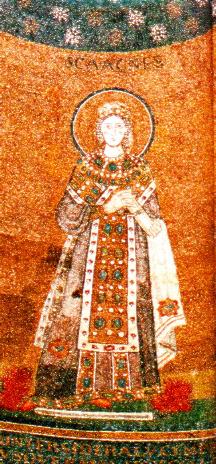
St Agnes, mosaic apse, Sant'Agnese, Rome
Frances Agnes Mason was born in Wales into a large Victorian family. Her brother, Canon Arthur Mason, became Chaplain to the Archbishop of Canterbury and wrote significant books, including The Relation of Confirmation to Baptism. Another brother, her favourite, Canon Edward Mason, became Head of St Bede's Theological College at Umtata, South Africa. She was herself a dedicated theologian, deeply drawn to Biblical Studies in Greek and Hebrew, and also working with the Mystics, such as St Teresa of Avila, St John of the Cross, Gertrude More and Julian of Norwich, holding Theology to be the Queen of the Sciences. In 1886 she took the Moral Sciences Tripos at Newnham College, Cambridge, and was Professor of Moral Science at Bedford College of the University of London, 1886-1889, at a time when few women could receive university degrees. She also held the Lambeth Diploma in Theology by Thesis, the Sisters of her Community shaping, and tutoring in, that Programme. She was passionate about teaching, especially the need for good teaching for women, world-wide, and was Secretary to the Guild of the Epiphany from 1887, the year following its founding by Canon Frances Holland for religious teaching, until 1895 when she resigned in order to found the Community of the Holy Family. Her abiding friendships were with the prime movers of the later period of the Oxford Movement, Frederick Temple, Archbishop of Canterbury, Charles Gore, Bishop of Oxford, William Collins, Bishop of Gibralter, Walter Frere, C.R., Bishop of Truro, Father Congreve, S.S.J.E., Lord Halifax and Baron von Hügel. She delighted both in art and in scholarship, being herself an exquisite water colourist, and knew and collected the works of Myra Luxmore, whose family were friends of Gerard Manley Hopkins, of Michael Fairless, sculptress and author of The Roadmender and Brother Hilarion's Passing, while Bertha James, a fellow Cambridge scholar, supplied the Community with a fine library of theological books and gave them St Pega's Hermitage, St Pega having been the sister to the Anglo-Saxon hermit, St Guthlac.

St Pega's Hermitage and its Chapel, now sold off and secularized

Myra Luxmore's painting of 'Christ Healing the Blind Man' I found in a junk room and begged the Sisters to replace it in Mother Agnes' St Mary's Chapel, which she had built from a stable. In an attic I found an altarpiece by Myra Luxmore of the Annunciation, which I believe is still there amongst cobwebs. Both paintings are based on Myra Luxmore's direct observation of the Holy Land and its people. To the left of Christ one sees the Sea of Galilee and the typical architecture of that region, while Christ wears the embroidered garb one finds there today.

Myra Luxmore, Christ Healing the Blind Man. Photograph, Revd Kenneth Clinch.
Mother Agnes tells how, while sitting in an olive tree above Florence, she first planned the Community of the Holy Family, a Community to be dedicated to the teaching of women of all ages, world-wide, and to be founded expressly for scholars and artists.
Much prayer and thought and counsel went into its formation. In Florence she would have worshipped and prayed at St Mark's English Church on the Via Maggio, the street that is famous for Elizabeth Barrett and Robert Brownings' Casa Guidi, the church designed and decorated by socialist disciples of William Morris. At Alinari's, she purchased sepia photographs of the great Italian contemplative art of the Quattrocento period for use in teaching. The background for this essay is taken from a detail of a Botticelli in the Uffizi in one of these precious sepia photographs. Later, she arranged for artist Sisters to teach in the Community's school in India, Naini Tal, and on their journey spend time in Florence to study its religious art.

Cantoria, Museum of the Opera del Duomo
These sepia photographs, over a century in age, are backed with brown paper from parcels, often with the Red Lion Square address. I have the entire portfolio, rescued from the flames of a bonfire.
She wrote the
following:
2. It is notorious that one of the most pressing needs of the Colonies is that of Religious Education: in particular that of good Secondary Education, religious and secular, for girls.
3. No English Community, so far as we are aware, has a Rule framed, as regards work, primarily with a view to Secondary Teaching or to work abroad.
4. In default therefore of women worthier to offer themselves for it, and encouraged by the sympathy and advice of Mother Superiors and other members of English Communities, both of men and women, we five members of the Guild of the Epiphany, desire to do what in us lies towards forming a Community of which the main work shall be the Secondary Education of girls in the Colonies.
5. Knowing that what a man is is more than what he does, we desire, first and before all, such conditions of Community life as shall be best for training good Sisters.
6. Next, the Rule must be such as to provide for making and keeping the Sisters thoroughly efficient as teachers and mistresses. We shall be content to aim at nothing below the highest standards of the time in all our work for our pupils.
7. As loyal members of the English Church, we shall desire to be knit up as closely as may be in its organization working under the authorization and guidance of the Bishop of the diocese, wherever we may be.
8. As at present, we propose to establish our Mother House and Novitiate in London, with a High School, and to send out thence Sisters, never less than three together, to places in the Colonies, as God may prosper us.
9. We are now studying and preparing for this life and work. We hope to begin our Community life early in 1896, and to open our High School not earlier than September of the same year.
10. Lastly, I ought to say that the above has been written by me, without consulting anyone. For that reason, and in order not to be tedious, I have not entered into details. We are, I think, agreed on certain important details both of principle and of method. But on others we cannot as yet even venture to form an opinion.
Frances Agnes Mason
29, St. George's Mansions
Red Lion Square W.C.
January 17, 1895
To his Grace the Archbishop of York
On October 19, 1898, the four Novices were Professed, the Archbishop of Canterbury being Celebrant, Canon Gore, Gospeller, and the Archbishop's Chaplain, Arthur Mason, Epistoler. + Agnes Mason, C.H.F., following her immediate election by the Sisters, was then installed by the Archbishop as their Mother Superior. Her brother Arthur had written the Community's Collect.
Though the Community never became large, due to the excellent scholarship of its Sisters it prospered at first, having its House of Prayer at St Pega's, its Houses of Study at Leeds and at Cambridge, schools in London, Hastings, and Naini Tal, India, and Sisters doing parish work.
One of my greatest joys in Community was to rescue from a roof leak, sort out and read through the Archives. A massive pile of Notebooks contain Sisters Charlotte's and Lucy's verbatim reports on Mother Agnes' talks given to the Sisters in Chapel. These are heady discussions on the Priesthood, on the Mystics, on Hebrew and Greek, and always on the need for compassion for the other, for the poor, for the refugee, for peace. The Sisters participate in dialogue with the Mother and it is like reading a Christian, an innocent, and a woman's, version of Plato's Symposium.
Among the documents in the Archives are the various numbers of a Journal called News from Other Lands, and sometimes also including Home News. This Journal was carefully typed up by Sister Charlotte, C.H.F., and often accompanied by photographs and even exquisite water colour sketches and pressed flowers, then that unique copy sent to the subscribers in South Africa, East Africa, Madagascar, Australia, New Zealand and California, each recipient sending it on to the next after reading it. Almost none of the volumes were lost though sometimes their posting from country to country across the globe could take up to two years and cross war fronts. Today Mother Agnes would have delighted in Internet and its capacity for global moral and theological education.
Several issues discuss the beauties of Holmhurst, first Mother Agnes' essay and its accompanying pencil sketches, October 1913, then Sister Charlotte's drawings and watercolours along with Mother Agnes's brother's photographs made when he was home on furlough from Umtata, South Africa, where he was head of St. Bede's College, July, October, 1914. The Archives also contain numerous photographs of Umtata's St Bede's College, including those of the elegant Edwardian marriages of its African priestly ordinands, their brides in beautiful handsewn white wedding dresses.
Though she was learned, Mother Agnes was also very much like a child. One finds great scholars, especially monastic scholars, have that combination. They can teach any soul of any age about joy, about how to be a child in the Kingdom of Heaven. Indeed, one very old Old Girl told us of Mother Agnes, sitting for hours reading a book beneath the tree that the child had climbed, then finally laughingly saying 'I know you are there'. Tiny Mother Agnes, after all, was herself a great climber of trees - and a swimmer. Mother Agnes Mason's account of beloved Holmhurst St Mary begins by describing the difficulties of the move, the children being in the beautiful house, the Sisters in cramped and very unhealthy quarters first in the Hospice, then in the Coach House, and no decent drains built yet. But she exults in the land, the views, and the architecture. She writes:


Then the wall of the terrace
has low bevels, and it is all covered with roses and myrtle
and more precious things ramping about; roses are the weed
of the place: it really is too beautiful to describe.



Drawing by Sister Lucy Knox, C.H.F., an Earl's
daughter, of Augustus Hare's Venetian Wellhead
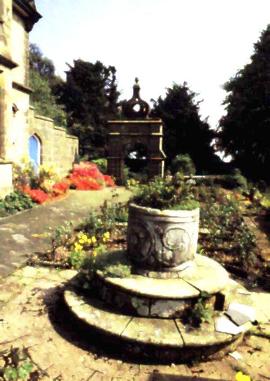
In thIS picture, taken by its present Chaplain General, we see the later decay of Holmhurst
Then inside the house; you go in - Companions have seen the picture of the porch with St. Cuthbert and St. Cecilia [since stolen], (with a Latin inscription-pax intrantibus-salus exeuntibus-benedictio habitantibus:) - then you go into a long hall, gallery we should call it in a College except that it is on the ground floor; an oak corridor, where Mr. [Augustus] Hare had collected all kinds of carved pieces of oak, all different, and all beautifully harmonious: it is all wainscoted, the whole of the gallery. We have made this into the children's dining room [Arcadia].

Then you go along this corridor into a beautiful room, the children's sitting room, with a bay window, looking over the terrace. There they have all their joys, rocking horse, etc [Utopia]. Then you go up a rather curious little staircase, a little winding staircase and you come to an upper corridor, where we have made two class rooms. We had a window put in and it has made a charming little classroom with a bookcase jutting out setting other things there, and beyond is another little class room [Beulah]. We shall be able to make room for a few more children by making ourselves a little more uncomfortable - before Easter - when we shall begin to build. . . .
Our Chapel will be a great joy to us; it is unmistakeably a stable [St Mary's Chapel]. I persuaded the men to leave the beams: it will be all white inside . . . then we have taken in a little shed at the back, making a beautiful little ante Chapel - we shall have the frontal case and a bookcase there - we can see the Altar. The Altar will be the one that we had here, and the four little windows high above it, as high as we could get them [Later glazed with Raphael, Gabriel, Michael and Uriel]. You come into the Chapel between the stalls. We are going to have the Crucifix put up on the gable of the Coachhouse [Ecco Amor Dei], and here we have a turret and bell.
The last cause for thankfulness is that we ourselves are extremely uncomfortable. In our Refectory there is not much room to sit at table as it is, and we have no other room, as the Library and Common Room [St. Theresa] we are using for a Chapel - we have only the Refectory to sit in. Then part of the table can't be occupied because of the bowls to receive the drippings of water when it rains. And I must confess we are very tightly packed-in the Hospice there are eight people where there ought to be five. It will be better when we have finished turning the coachhouse into bedrooms. There will be more room for children after that.
Sister Veronica Markham had brought into Community a gift from her brother, a first edition Richard Hooker, Ecclesiastical Polity, inscribed to Mary Hooker, and she tutored in the Lambeth Diploma; Sister Christine Ward, an artist, was sent to India so that she might study art in Florence on the way; Sister Mary Hett began the St Mary's School Sixth Form, herself being the first woman to hold the Ph.D. in Biology; Sister Helen Kemp studied art, taught Latin, bound books, and learned Hebrew in old age, propping up her Hebrew grammars above the stove while she cooked the children's meals at the Stonecourt Junior School (you could too, it's easier than Greek, I did it in my fifties); Sister Katerina Rein brought into Community a splendid library of shelves and shelves of German literary classics in fraktura; Sister Valerie taught us Florentine drawn-thread work, church embroidery and herself did William Morris-like work. At one point, Mother Agnes says, the Sisters revolted and decided to have no more paid staff do the cleaning, but to do it themselves in the spirit of St Clare's 'Privilege of Poverty'. These were my teachers. There one was with the Shekinah, in the presence of God. They were priestly women. The children of the school continued her traditions, Lydia Lambert her theology and her social concerns, Joan Ponsonby Wright, her art, Angela Lovett-Turner, her classical scholarship, Patience Marshall, O.B.E., her love of learning, Joanna Lumley, O.B.E., all of these.

St Agnes in mosaic at Sant'Agnese, Rome, where the nuns keep lambs, spinning and weaving their wool into the pallium sent by Popes to each Apostolic Bishop.
Just as Mother Agnes Mason's own words best give the beginning of the Community, so do her own words best prophesy its continuum in a talk she gave, perhaps the last of many, and in the year that I was born, to the Sisters. I can imagine her leaning upon her silver-headed stick giving these words, filled with eternal innocence.

General
Mother Agnes
Aug 28th 1937
'Pherometha [in Greek]'
Heb 6.1
Perhaps the reason why it is considered a good thing to think about our Community motto is because altho' it had an obvious application to the little party - of children as we were at the beginning - we might think that now there is not the same need for it - that it has very little application now - taking 'perfection' to be only the same as maturity. We have come to maturity; we have got what we planned for - two schools in England, a school abroad, a House of Study, a House of Prayer, the original Mother digged up & a new one happily planted, a new generation of Postulants coming. We have changed. The immediate application of our motto has changed. But we are not in a different state, but in a different stage; our motto is one of movement, not of a state; & a movement that is to continue until we are at the fulfilment, ending - ferwmeja - which will not be within the next day or two.
So our motto does apply as much now as it did at the beginning.
We were meditating on Hebrews when we began. I think we all know that what is translated in Heb. 6.1 "go on" is not walk on, but be borne on. And that our whole motto is 'let us be borne on to perfection'; not only being borne, but we are to be forever carried on, to perfection. Not trudging along a hard road; the road goes uphill all the way, to the very end; but the ascents are in our hearts, not in our feet to trudge up; we are not just trudging.
There are plenty of lessons to be learnt from walking, running, "they shall walk & not be weary, they shall run & not faint", etc. But our particular lesson is not walking or running; but being borne, or carried; carried on because Christ is the Way as well as the Truth & the Life. We are borne on a living way - a water way, which, if we will, carries us on to the Perfection we ought to achieve.
This is not drifting; if we drifted, plainly, along a river we should be pretty sure to come to the bank & stick, or something else will happen. But we are to be active in response to the running of the river. We must keep ourselves in mid-stream. And it is not always easy in mid-stream. In the huge rivers of America, India, etc., it is often stormy; strong waves too rough for us; we want to get to the side; we don't like the rough waves in the middle; we wonder what will become of us; we may come to rapids, sudden gusts take our sail, drive us towards the shore; under-currents suck us out of the straight way if we are not watchful; we find ourselves drawn sideways; there are whirlpools & all kinds of difficulties in keeping ourselves in mid-stream. But we must keep in mid-stream; so doing we are borne on. There may be even moral temptations to voyagers; a nice place at the side, surely here is a haven of rest where we may be for a bit, not go on always in the strong stream drawing us on; a quiet place; not always on & on.
It is not a passive thing by any means. It means a certain trust in the stream; & courage, to keep in mid-stream. And that is a persevering faith, confident because we are sure that we have our way. "I am the Way" "Jesus Christ the same yesterday & today & for ever" Or as we sing of the ladder (reference to carol "Jacob's Ladder") we have every reason to trust our Saviour Christ. We may be sure He will lead us where we have to go, if we will keep in Him, in His power led by Him, drawn on by Him.
He is the same Jesus of whom we read so much in Hebrews - upholding all things by His Power - not statically, but bearing along everything; the course of the whole world, all things in Heaven & in earth. His Providence ordereth all things. Here is no lack of strength to carry us on.
And there is no lack of love to carry us. He is the Good Shepherd. There is the specially poor sort of sheep; He lays it on His shoulder rejoicing; & all the other sheep too. We have only to do that - and trust our Way, the living Way, the so we may be borne on.
(Story of young doctor who desired to become a Christian - that she might 'be carried')
What Christ calls us to do He makes us able to do. What He calls us to bear He makes us able to bear; otherwise we would not be able to do it at all.
Towards what are we borne on? Perfection. That perhaps seems rather a contradiction. In our Rule we say that 'our aim is not our own perfection but God's glory'. That of course is not really a contradiction; but the paradox that runs through the whole spiritual life. He who seeks to save his soul loses it. If we think too much about our soul we are losing it & doing harm to others. The only way to save our soul is to lose it-for Christ's sake. We must be ready to lose ourselves. So we go on towards Perfection, by not aiming at it in ourselves as making it our ultimate aim, but only as a means to the glory of God.
What is our Perfection?
The Community is to be borne on ferwmeja 'to perfection'. What is that? The Perfection of every Community is to be a nucleus, a mode, of the love of Jesus Christ; it is to be a nucleus in the Church, of that love; & the way to that, the method of that, is by self-surrender, to follow the Lamb whithersoever He goeth. That is our side of it; from the Church's side - the Community is that - the special ganglion - of the love of our Lord, in the Church.
And in our Community (each Community has its own special way of increasing that love) we want to have learning & art in our Community. We want beauty & to be able to teach these to our children. And therefore every Sister should specialise in what she has learnt & knows something of; so each Sister's perfection, as far as learning & work is concerned, should be a special contribution to the perfection of the whole. So that we should not be people of all work, knowing a little of everything & all badly. We must 'aim at the highest standards of the time'; not the popular standard. We have never, e.g. gone in for fashionable things, Montessori, etc., but for good education.
Then for Sisters; we say as regards works the Community is the unit. Each Sister has a different share in it; best for each in the interests of the whole Community. But in the life the Sister is the unit, the individual. i.e. We each, in the imitation of Christ, the following of Christ, each follow in a different way. We ought each to follow & in a different way to attain the Perfection to which we may be called, God's call for us.
What is the Perfection of each of us?
It won't be Christ's Perfection. Hebrews keeps on shewing how He is our perfect High Priest, shewing how He learned obedience & suffering. In the 17.4 of St John, the great prayer of our Lord, He says, 'I have finished the work'. He goes on to say on the night of the Supper the work was finished, but not till the very end of the sufferings of the Cross was He able to say 'It is finished' [Greek text]. All that He had to offer; all that he had to learn, was finished. All that He had to do for mankind. This is fully expressed in the Consecration Prayer; the words are heaped up in the Prayer Book, One, Perfect, sufficient sacrifice, satisfaction, One offering of Himself, once offered. Not one word, one deed, one pain left out. All was suffered, perfectly perfect.
Our perfection will not be like that; it is not meant to be like that. Our Perfection is the perfection of imperfection. As St Paul shews in his description of the Body of Christ, there is a real perfection of imperfection. The perfection of each of us is meant by God to be a different perfection & as to what it is to be & to how it is to be brought about we say we must be ready to believe that the will of God will be made known to us thro' the Community.
And all the things that seem most for our imperfection (if we trust the Community) may be - the things we mind most, even morally - the very things that make for the perfection which God desires for each of us. Not only acts of God, but also acts of other people, thwartings, pain caused by others' imperfections or by our own may be really the means towards our perfection. As in great saints God leaves some small, petty imperfection that they hate, & can't bear, on purpose to help them to go on to their own true perfection, not to drift to one side; there's the imperfection they find their perfection. They can only be perfect as God makes them perfect thro' Jesus Christ our Lord. So for us. And besides that individual perfection we see for ourselves every day one person's imperfection bringing out something very good & beautiful in another. That person's imperfection, that they are bitterly sorry for, but can't help it, & can't see how it is helping the other, how it is for the good of the other, yet is making for perfection.
So we may be quite sure, if we are faithful, trusting in the Cross, in the Power of the Cross, in the Power of the Lord's Risen Life, in the Sacraments, not in our own power, we may be quite sure that by the time we come to our end we shall be not perfect as Christ is perfect, but so far as God meant us to be perfect; the stage of perfecting God meant us to reach in this life will be achieved; we shall be just ready to go on to the next stage in the life to come, however imperfect we seem ourselves & to other people. God will carry us on to perfection. He will carry the Community on to perfection. He desires for it, & each one of us to our perfection. Those who have gone before us are being carried on - each to fulfil their own part in the Body, into the perfection not of an eye, not of an ear, not of a foot or a hand, but the perfection of whatever it may be that edifies the Body of Christ, building up the Body of Christ into a perfect man, the measure of the stature of the fulness of Christ, Christ found in us. That must be for the Community, as for each one of us.
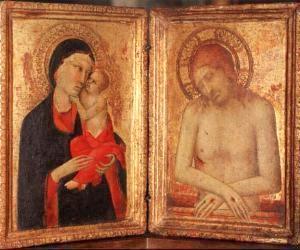
The Community Altar Cross's inscription,
from Psalm 119.97, plays with the name of its Foundress,
illustrating the Lamb of God ('Agnus', similar to 'Agnes'), and
giving that verse in Hebrew, 'How I love your law; all day long
it is in my mind', ('Mah ahaboth torathika, kal ha-yom hia
sikhati. . .'), referring to the Commandments, the Torah,
the Gospel, of the Bible, and also to
the Rule given to the Sisters by the
Mother Foundress, Agnes Mason, C.H.F. It learnedly gives her own
name and those of her priestly brothers while doing so. From the
Trust documents, I found that the liturgical furnishings of the
convent were given to the Gatwick Airport chapel, while other
items were sold privately by the chaplain general and his wife.
The library has now been inaccessible for years, and I have
attempted to create another in its place with the Biblioteca e Bottega Fioretta Mazzei,
here in Florence, where Mother Agnes Mason, C.H.F., first
conceived of her Community of the Holy Family. All I have is a
rosary given me by Mother Superior Kathleen Mary, C.H.F., that
had belonged to one of the original Sisters, the bedspread, a
white sheet with a blue cross, a Victorian wooden book-binding
press, some of the Hebrew books (a Bible, a Psalter, a
dictionary, a grammar), and a portfolio of Alinari photographs
of Florentine art works, that were almost burned as rubbish, but
which date to the nineteenth-century visit by Mother Agnes
there. These are sufficient for the ferwmeja, the
continuing of Mother Agnes Mason, C.H.F.'s teachings. Which is
what we were taught, in our day the Sisters being poor, that the
love of God, the learning of skills were of greater value than
physical objects.

John the Baptist and Jesus Christ as Children of the
Holy Family
See also Saint Teresa of
Avila, Foundations,
trans. Agnes Mason CHF, Agnes
Mason's Holmhurst St Mary, Blue-Red
Print
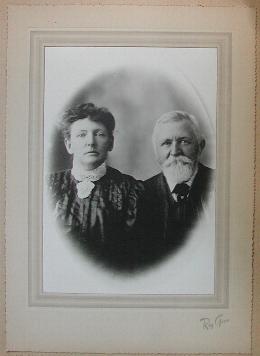
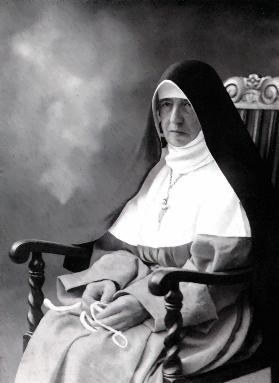
To see an example of a page inside with parallel text in Middle English and Modern English, variants and explanatory notes, click here.
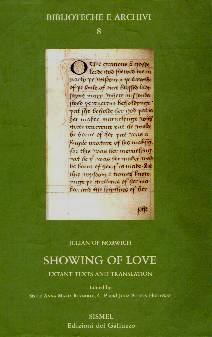
To Julian of Norwich, Showing of Love:
Extant Texts and Translation, ed. Sister Anna
Maria Reynolds, C.P. and Julia Bolton Holloway
(ISBN 88-8450-095-8), 848 pages, 18 full colour plates
of the manuscripts, from University of Florence, SISMEL
Edizioni del Galluzzo, 2001, 191 euro, e-mail
order@sismel.itaor Julia
Bolton Holloway
 Sister
Anna Maria Reynolds C.P. was the greatest editor Julian ever
had. During the war years she was transcribing the extant
microfilms with a microscope, a word at a time, for her
Leeds University MA and Ph.D. theses. Subsequent editions
are based on her meticulous work.
Sister
Anna Maria Reynolds C.P. was the greatest editor Julian ever
had. During the war years she was transcribing the extant
microfilms with a microscope, a word at a time, for her
Leeds University MA and Ph.D. theses. Subsequent editions
are based on her meticulous work.
| You can donate to this website through
clicking on this PayPal button: Thank you very much! |
JULIAN OF NORWICH, HER SHOWING OF LOVE
AND ITS CONTEXTS ©1997-2024 JULIA BOLTON HOLLOWAY
|| JULIAN OF NORWICH || SHOWING OF
LOVE || HER TEXTS ||
HER SELF || ABOUT HER TEXTS || BEFORE JULIAN || HER CONTEMPORARIES || AFTER JULIAN || JULIAN IN OUR TIME || ST BIRGITTA OF SWEDEN
|| BIBLE AND WOMEN || EQUALLY IN GOD'S IMAGE ||MIRROR OF SAINTS || BENEDICTINISM|| THE CLOISTER || ITS SCRIPTORIUM || AMHERST MANUSCRIPT || PRAYER|| CATALOGUE AND PORTFOLIO (HANDCRAFTS, BOOKS
) || BOOK REVIEWS || BIBLIOGRAPHY ||
